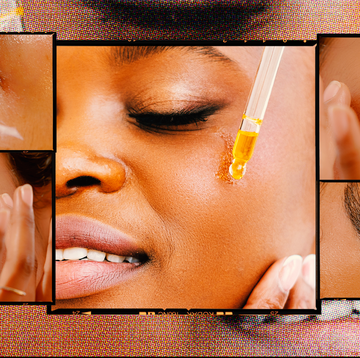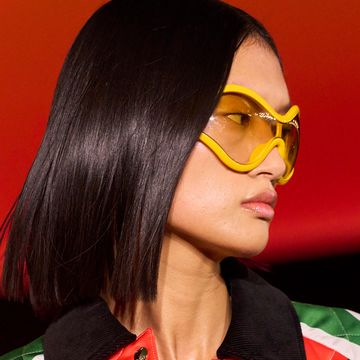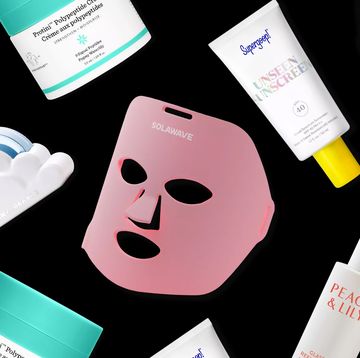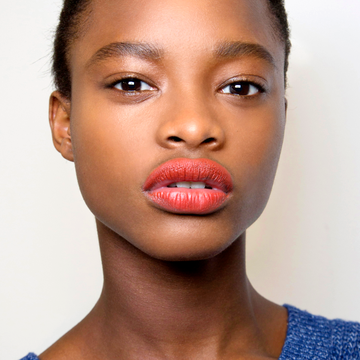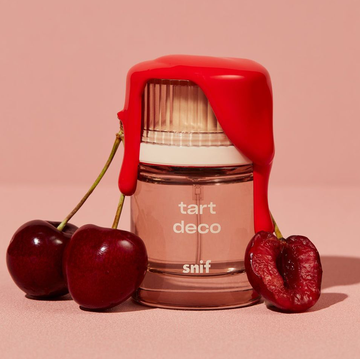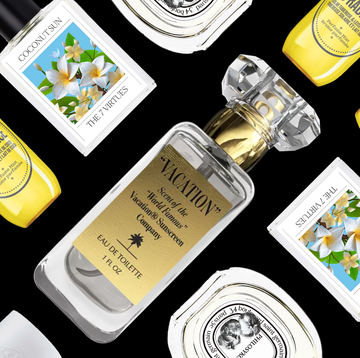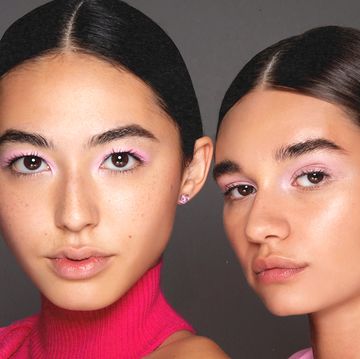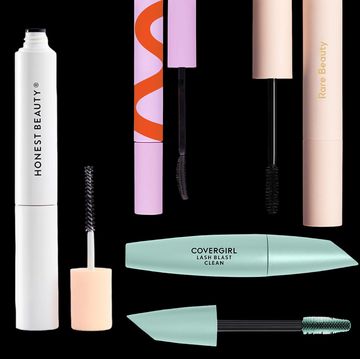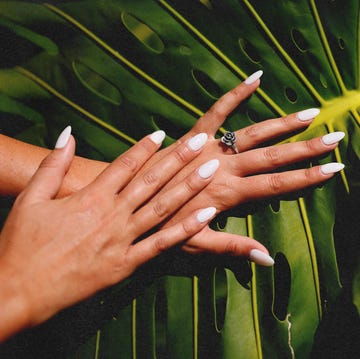I knew I wanted CK One before I even knew what it smelled like. It was 1994, and the black-and-white magazine ad was amazing. Models who looked like art-school dropouts lolling next to those who could pass for Lollapalooza headliners, and slouching near the center: Kate Moss. With her cutoff skirt and crossed arms, she didn't look angry, she looked indifferent. Like she would walk right out of that perfume ad, if only she could be bothered.
I wanted in.
So did a lot of girls my age. The unisex gimmick seemed impossibly sophisticated. The scent was bright and clear — what I imagine a shooting star would smell like, cut with a twist of lemon. I tossed my gardenias and made space on my dresser. I was suddenly part of the cool-girls club.
For the first time, it was clear that fragrance didn't have to come in a pat, pretty package. It didn't need to be big-cleavage sexy. It could be smart — even a little weird. Wear the right one, and oh, you know something I don't. The new scent sensibility: Not as obvious as carrying an It Bag and way more intriguing.
Trying to predict the next It Scent never works — even slapping Kate Moss in an ad won't guarantee it. Plot the hit fragrances of the recent past on a timeline and it becomes clear that it takes a collision of factors — cultural, economic, and the shifting tides of taste — to give an offbeat scent staying power.
The Birth of Cool
As a teen in the mid-'90s, my fragrance options were limited: I could choose from the super-glam orientals on my mother's dresser (Calvin Klein Obsession, Yves Saint Laurent Opium) or a body spritz that smelled like a Jolly Rancher (and was just about as sticky).
When CK One arrived, it was like a palate cleanser.
"It was clean and unisex," says creator Ann Gottlieb. And for that reason, almost shocking. "The most popular fragrances were so heavy at that time." She admits that selling a unisex splash (in a no-frills flask) was a huge commercial risk. "It could have easily gone up in smoke — but it didn't."
Key to its success: Calvin Klein. "He was so hot then and gave us permission to like something that was actually counter to the trend." Also, that ad. "Those grungy kids looked cool to some, dirty to others," she says. In an era when Kurt Cobain was a fashion muse, the scent game had taken a sharp turn.
"It was like the perfumers said, 'We're done setting off scent bombs in elevators,'" says fragrance expert Emily Friedman, Ph.D., an assistant professor at Auburn University.
As lighter scents flooded fragrance counters, Issey Miyake L'Eau d'Issey, launched in 1992, had its moment. Its scent seemed simply a fresher version of human … not like you actually went out of your way to put on perfume. As if. Wearing anything OTT just seemed lame — like you were stuck in the past.
It's been two decades since these splashed onto the scene, but they still seem youthful and rebellious — in that Kate Moss kind of way.
The Hippie Movement
Of course, not everyone worshipped Kate and Kurt in the '90s. While grunge was having its moment, a major '60s revival was on. Friends of mine — people who missed Woodstock by decades — were skipping town to follow the Grateful Dead and building entire evenings around listening to a single Pink Floyd album. The coolest boho chicks? They carried around curious-looking vials of patchouli and incense.
"These scents weren't high-brow. They were a rejection of slick, big-budget perfumes," says Friedman. (Flashback to the mall kiosk where you could buy dream catchers and "All Natural!" roll-on oils.)
Still, others had power. Across the mall, you could hit up the Gap for the ultimate neo-hippie scent: Gap Grass. The scent of a wet, freshly cut lawn, this eerily accurate perfume was a huge hit, proving you didn't have to be a Deadhead to smell like one. (Ultimately, it was discontinued.)
Natural scents are once again thriving — only now, in a more sophisticated way. Not surprising, really: When we're buying Birks from Net-a-Porter and dropping a tenner for juice, earthy fragrances were due for a posh makeover. Today, brands like Aftelier Perfumes, Tata Harper, and Juniper Ridge are turning out some of the most luxurious oils to date, putting equal emphasis on their wild-crafted, sustainably harvested ingredients as on their herbaceous tang. Big brands like Givenchy and Dior are regularly getting their Bonnaroo on, incorporating earthy notes into their lush scents. Gap Grass even has its own Facebook page: Bring Back Gap Grass. Call it natural evolution.
Oud Revolution
My first foray into the working world was in the early 2000s at a fashion magazine — but it smelled more like a gentlemen's club. The largely female staff wore heavy, masculine notes of leather, tobacco, and wood, which gave the halls a badass, androgynous vibe.
The borrowed-from-the-boys thing got more serious in 2002, when YSL dropped its unisex game changer M7 Oud Absolu. It put oud (pronounced oohd) — a pricey, resinous wood, previously found only in Middle Eastern scents — center stage, says Michael Edwards, author of the scent bible, Fragrances of the World. M7 inspired the world's perfumers, but most of us didn't experience oud until around 2007, says Luca Turin, coauthor of Perfumes: The A-Z Guide. That's when perfumers started looking for new base notes. Among the usual players, "sandalwood was endangered and oak moss was restricted" as it has allergic potential, says Turin.
At the same time, the Middle East was reemerging as a jet-setter destination: Dubai had cemented itself as the Las Vegas of the Middle East, Carrie Bradshaw and Co. were riding camels in the desert, harem pants were a viable going-out look, and oud was everywhere. Retailers on our shores were stocking their shelves with this exotic scent not just to satisfy our (newly) sophisticated taste but also to fill their own pockets.
"The Persian Gulf countries have one of the highest per capita spending on fragrance in the world — obviously Western companies would love a slice of the business," says Edwards.
When Tom Ford debuted his label's first oud in 2007, it was officially on. The motives may have been market-driven, but the results were glamorous. The chicest people I knew were floating around in a cloud of the stuff (most of whom couldn't pronounce the word a year before!).
"Oud is big in the way that '80s power scents were," says Friedman. If the grunge and hippie kids responded to washed-out and low-key blends, it's perhaps fitting that the go-getter, selfie era would gravitate toward something more assertive.
The New Rock Star
A few months ago, I saw Ann Gottlieb gripping what she claimed was the next big thing in fragrance: a big, ugly hunk of salt. I had to take her seriously — she did create CK One, after all.
Salt doesn't sound very sexy, but it gives the newest Calvin Klein scent, Reveal, an overtly sensual air.
Gottlieb has worked on thousands of fragrances in her mega career, but this is the first time a grain of salt has passed her desk. She initially geeked out on its technical ability ("it cuts through the fragrance, keeping it from smelling sticky sweet") but was largely seduced by another factor: It was unexpected.
"Discerning customers want more from their fragrance," she says. "It's not enough to have bergamot and Moroccan rose in a perfume. Now salt — that's totally counterintuitive."
Well, somewhat. While unusual in a fragrance, this note is very much on cue, says Mark Bitterman, author of Salted, the James Beard award-winning book. "Just six years ago, there was a pretty universal perception that salt is just salt," he says. "What people had completely forgotten was that historically, salt was once the most exotic, fought-over substance on earth. What's more interesting than that?"
Much to Bitterman's delight, "Fleur-de-sel ice-cream bars are now available in supermarkets, flaky sea salts are served in restaurants, and solar-evaporated salts are de rigueur for healthy food makers." Surely, the fragrance counter can't be far behind.
"Salty notes are definitely popping up right now," says Karl Bradl of Aedes de Venustas, the specialty Greenwich Village beauty emporium. He traces the trend back to the Different Company's Sel de Vétiver — a cult favorite since 2006. "These salt accords are a more refined alternative to the calone molecule, which is typically used to create an aquatic feeling but can sometimes smell melony and cheap," Bradl says.
Cue Jo Malone London's new Wood Sage & Sea Salt fragrance. Inspired by the gray, rocky English seaside, it is by definition aquatic yet smells nothing like its vacation-y cousins. In fact, coworkers kept stopping by my desk to get a whiff of it — along with Reveal — and coming back to repeat the process. Unique, curious, and stopping people in their tracks — these scents are, as Gottlieb promised, the new definition of cool.
Eau De You
Recently, I asked a painfully stylish girl what perfume she was wearing. (She smelled divine.) She looked at me smugly and said, "Y'know … a bunch of stuff."
I should've known. Over the past year, there's been another trend rumbling — layering multiple scents to create a custom blend. It makes perfect sense: When everyone's striving to be seen as an individual, what's cooler than a super-secretive blend?
While some in the fragrance world turn their nose up at the concept ("It's like popping two fine wines in a glass and going 'Oooh!'" says Edwards), others think it's all about method. "Instead of layering two complex fragrances, add a single-note perfume to a complex scent," suggests Bradl, who recommends adding rose to woody scents, fruity notes to aquatic blends, and — this one's easy — musk to almost anything.
This article was originally published as "What Cool Smells Like Now" in the November 2014 issue of Cosmopolitan. Click here to get the issue in the iTunes store!


